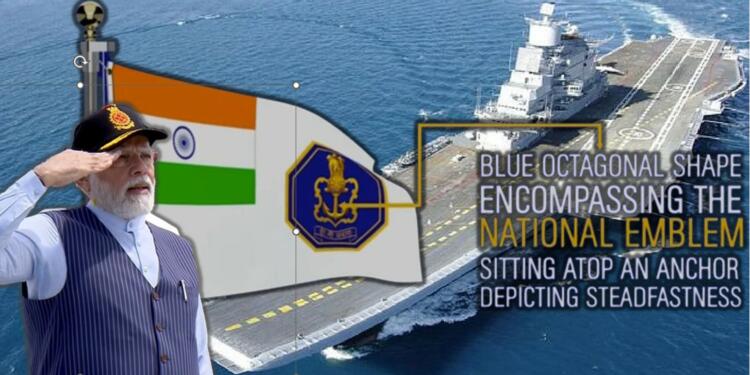The most prominent aspects of the colonial rule of European powers were inscribed in their naval capabilities. Using their early discoveries of different navigational equipments like a compass, they successively established rule in India and several other countries of the world. In that era, India was under the rule of the Mughal Empire. They lacked the capabilities to make a formidable naval force. Due to this, many European forces like the Portuguese started to monopolize and control the western trade route of India. And, in the end, they managed to establish colonies in Goa and other Konkan regions.
When the wickedness of European naval forces increased in the Arabian Sea, it was the Marathas under Chhatrapati Shivaji Maharaj who challenged their monopoly and established the first naval force in India. They not only challenged the might of Europeans in trade routes but also protected the western coast of Konkan regions from becoming a colony of the Europeans.
Shivaji’s seal on the Navy’s new ensign
Today Prime Minister Modi unveiled a new ensign of the Indian Navy in Kochi, Kerala. Ahead of the commissioning of IAC Vikrant, PM unveiled a new Indian Navy flag consisting of a Tricolour in the upper left symbolizing the spirit of India’s naval force. In the lower right corner on the fly side, it contains the Navy’s new insignia. The new ensign imprints the national emblem with the national motto and the Navy’s motto “Sham no Varunaha” inside a blue octagon. The golden border of the octagon represents the Rajmudra of Chhatrapati Shivaji Maharaj.
BREAKING: @IndianNavy’s new ensign unveiled, drops St George’s Cross, introduces Indian Navy crest on a navy blue background enclosed in a octagon representing the royal seal of Chhatrapati Shivaji Maharaj. pic.twitter.com/NUh68yt85r
— Shiv Aroor (@ShivAroor) September 2, 2022
The earlier ensign, which contained St George’s Cross, has finally been removed. The cross is a part of England’s national flag, which has been inscribed on the Indian Naval flag. St George is regarded as a military saint and the red cross on a white background is a symbolic representation of the Christian crusaders. Owing to the colonial past, like other symbols of slavery, the St George Cross was also representing coloniality.
Maharashtra Deputy CM Devendra Fadnavis, celebrating the adoption of the new ensign, said, “Today is a moment of great pride and glory for every Shiva devotee of Maharashtra. Another sign of the colonial past was erased today and replaced by a new sign in the shape of the royal seal of our beloved, knowledgeable King, Chhatrapati Shivaji.”
तिरंगा आणि राजमुद्रा…
आज प्रत्येक शिवभक्तासाठी, महाराष्ट्रासाठी अत्यंत अभिमानाचा आणि गौरवाचा क्षण आहे.
पारतंत्र्याची आणखी एक निशाणी आज पुसली गेली आणि त्याजागी आपल्या लाडक्या, जाणत्या राजाची, शिवछत्रपतींच्या राजमुद्रेच्या आकारातील नवी निशाणी स्थापित झाली!#IndianNavy #Ensign pic.twitter.com/jNckew72k8— Devendra Fadnavis (Modi Ka Parivar) (@Dev_Fadnavis) September 2, 2022
Shivaji Maharaj- Father of the Indian Navy
The inscription of the royal seal of Chhatrapati Shivaji Maharaj on the Indian Naval flag has a very significant meaning. In the early 16-17th centuries, when Europeans started to monopolize the sea route with their strong naval forces, India under the Mughals didn’t have even a niche naval force. The British, the Portuguese, and the Dutch had already made their presence known on Arabian trade routes. Now, they started to build colonies over Indian lands. The Portuguese even managed to establish their colony in Goa.
Considering the threat from foreign powers, Chhatrapati Shivaji Maharaj realised the importance of having a Naval force and the need to secure the Indian coastline. He built ships in towns like Kalyan, Bhivandi, and Goa. He also built numerous sea forts and bases for repair, storage, and shelter. According to the Navy documents, Shivaji Maharaj fought many naval battles with the Siddis of Janjira on the coastline. He had from 160 to 700 merchant, support, and fighting naval ships. After reaching the capacity of building the naval force, Shivaji Maharaj started trading with foreigners on his own and challenged the monopoly of the Europeans.
The most important soldier of the Maratha Navy was Kanohji Angre. He is considered the foundational pillar of the strong naval powers of the Marathas. When Europeans were attacking and charging huge taxes on Indian merchants, it was Kanohji Angre who challenged their monopoly. He launched many rounds of attacks on European ships and collected Jakat from them. It was the fear of Admiral Angre that Europeans, during the Maratha timeline, did not establish their colony in Mumbai.
Adoption of a new ensign on the Indian Navy’s flag is not only a significant step in freeing ourselves from colonial symbols. The new ensign also recognises the contribution of Chhatrapati Shivaji Maharaj in building the legacy of the Indian naval force.
Support TFI:
Support us to strengthen the ‘Right’ ideology of cultural nationalism by purchasing the best quality garments from TFI-STORE.COM































